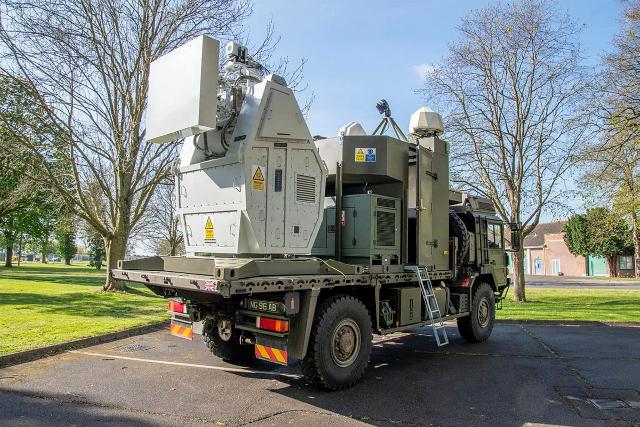
The UK Ministry of Defense (MoD) has unveiled a new direct-energy system it says can neutralize individual and swarms of drones using high-powered radio waves.
The MoD said its Radio Frequency Directed Energy Weapon, or RFDEW, blasts radio waves at incoming enemy drones, rendering their internal electric elements useless. The counter-drone platform is effective from up to one kilometer away, and in contrast to other direct-energy systems developed, costs just 10 pence ($0.12) per shot.
In addition to its effectiveness in zapping enemy swarms, its economy of use solves a problem that armies developing drone defenses have faced. That dilemma involves decisions about using counter-drone assets that can cost thousands of dollars per blast – or missiles that can run over a million – to destroy what are increasingly cheap, easily replaceable enemy craft.
That balance between urgent security priorities and financial viability of aerial responses now looks close at hand.
“At only 10p per shot fired, the RFDEW beam is a significant cost-effective alternative to traditional missile-based, air defense systems, capable of downing dangerous drone swarms with instant effect,” the MoD announcement of the anti-drone system said.
The platform is still under development, and testing continues as the MoD seeks to extend its distance. But it already promises hope that the RFDEW will vastly lower the costs of other high-energy drone defense systems – including the UK’s economic DragonFire laser.
Though unlikely to be ready for deployment in Ukraine’s defensive war against Russia, both the concept and development of RDFEW was clearly influenced by Kyiv’s constant worry of exhausting its limited cash and materials reserves to destroy countless incoming enemy drones. It also reflects the anticipation of armies around the globe that small UAV deployment will be increasing as time goes on.
“The war in Ukraine has shown us the importance of deploying uncrewed systems, but we must be able to defend against them too,” said the MoD’s Minister for Defense Procurement, James Cartlidge. “As we ramp up our defense spending in the coming years, our Defense Drone Strategy will ensure we are at the forefront of this warfighting evolution.”
The MoD said the system can can detect, track, and engage a range of drone threats over land, air, and sea, then beam high-powered radio waves to disrupt or damage critical electronic components of those UAVs, which then drop from the sky.
Image: MoD
FTC: We use income earning auto affiliate links. More.



Comments